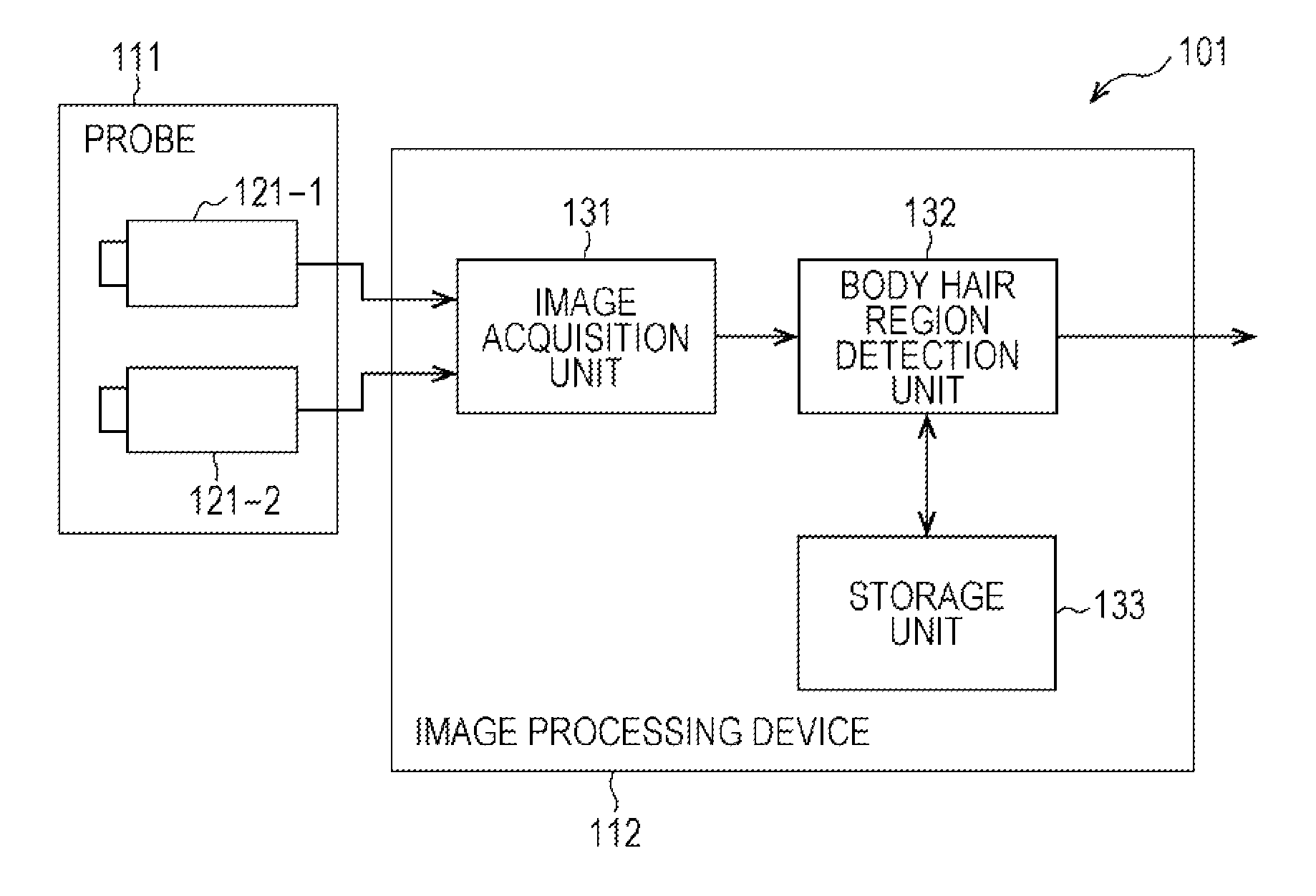Image processing device, image processing system, image processing method, and program
a technology of image processing and body hair, applied in the field of image processing devices, image processing systems, image processing methods, and programs, can solve the problems of difficult to accurately detect the shape of sulci cutis and cristae cutis if a body hair is present, and the analysis precision becomes lower, so as to achieve the effect of accurately removing body hair in an image, easy and accurate detection, and easy and accurate detection
- Summary
- Abstract
- Description
- Claims
- Application Information
AI Technical Summary
Benefits of technology
Problems solved by technology
Method used
Image
Examples
first embodiment
[0085]
[0086]Referring first to FIGS. 1 through 12, a first embodiment of the present technique is described.
[0087][Structure Example of Image Processing System 101]
[0088]FIG. 1 is a block diagram showing an example of functional structure of an image processing system 101 as a first embodiment of an image processing system to which the present technique is applied.
[0089]The image processing system 101 is designed to include a probe 111 and an image processing device 112. The image processing system 101 is a system that detects a region that shows a body hair (hereinafter referred to as a body hair region) in an image formed by bringing the probe 111 into contact or close proximity with the skin of a person (hereinafter referred to as a skin image).
[0090]The probe 111 is designed to include two photographing devices: photographing devices 121-1 and 121-2. The photographing devices 121-1 and 121-2 may be formed with cameras that are capable of taking closeup images from very short dis...
second embodiment
[0149]
[0150]Referring now to FIGS. 13 through 16, a second embodiment of the present technique is described. The second embodiment of the present technique is the same as the first embodiment, except for further including a function to remove a body hair from skin images.
[0151][Structure Example of Image Processing System 201]
[0152]FIG. 13 is a block diagram showing an example of functional structure of an image processing system 201 as the second embodiment of an image processing system to which the present technique is applied.
[0153]The image processing system 201 is a system formed by adding a function of removing a body hair from skin images to the image processing system 101. In the drawing, the components equivalent to those in FIG. 1 are denoted by the same reference numerals as those used in FIG. 1, and explanation of the components that perform the same processes as above is not repeated herein.
[0154]The image processing system 201 differs from the image processing system 1...
third embodiment
[0169]
[0170]Referring now to FIGS. 17 through 23, a third embodiment of the present technique is described. In the third embodiment of the present technique, a body hair region is detected by using three or more skin images acquired by photographing the skin from three or more different directions.
[0171]Since a body hair is in a linear form, it is preferable to capture skin images from two directions that are perpendicular to the extending direction of the body hair, as described above with reference to FIG. 6. This is because doing so will increase the probability (or the area) that a skin region hidden by the body hair in one skin image is not hidden by the body hair but is shown in the other skin image.
[0172]However, a body hair does not always extend in one direction but may extend in various manners. Therefore, skin images are not always captured from two directions perpendicular to the extending direction of a body hair. For example, as shown in FIG. 17, there are cases where ...
PUM
 Login to View More
Login to View More Abstract
Description
Claims
Application Information
 Login to View More
Login to View More - R&D
- Intellectual Property
- Life Sciences
- Materials
- Tech Scout
- Unparalleled Data Quality
- Higher Quality Content
- 60% Fewer Hallucinations
Browse by: Latest US Patents, China's latest patents, Technical Efficacy Thesaurus, Application Domain, Technology Topic, Popular Technical Reports.
© 2025 PatSnap. All rights reserved.Legal|Privacy policy|Modern Slavery Act Transparency Statement|Sitemap|About US| Contact US: help@patsnap.com



